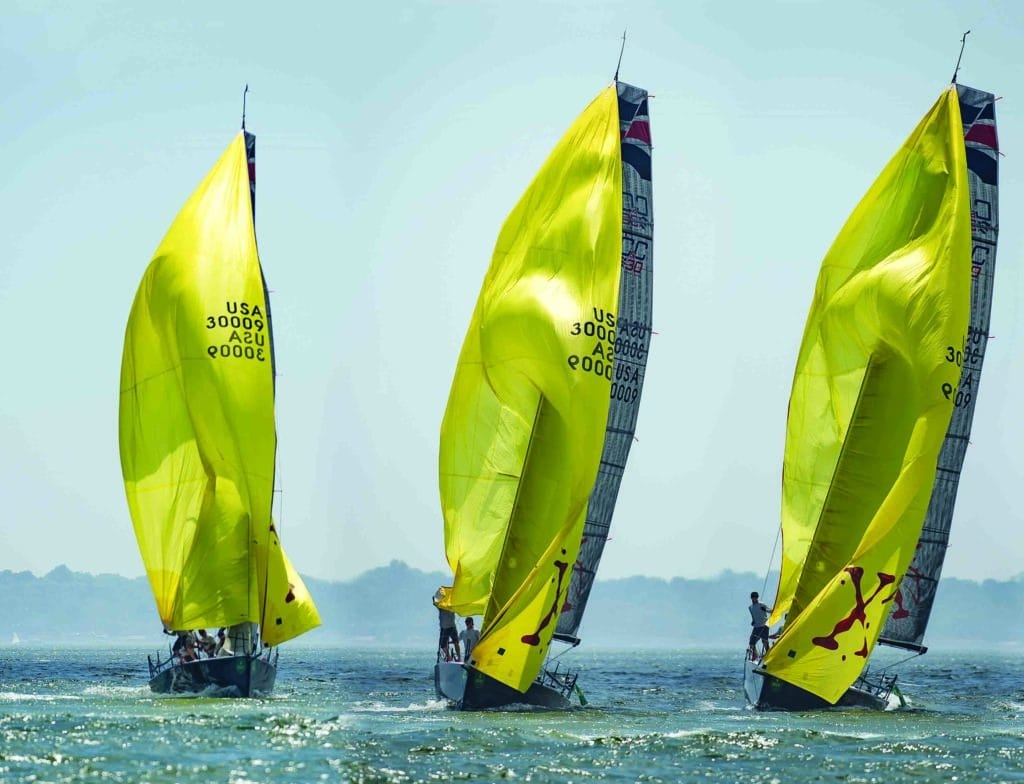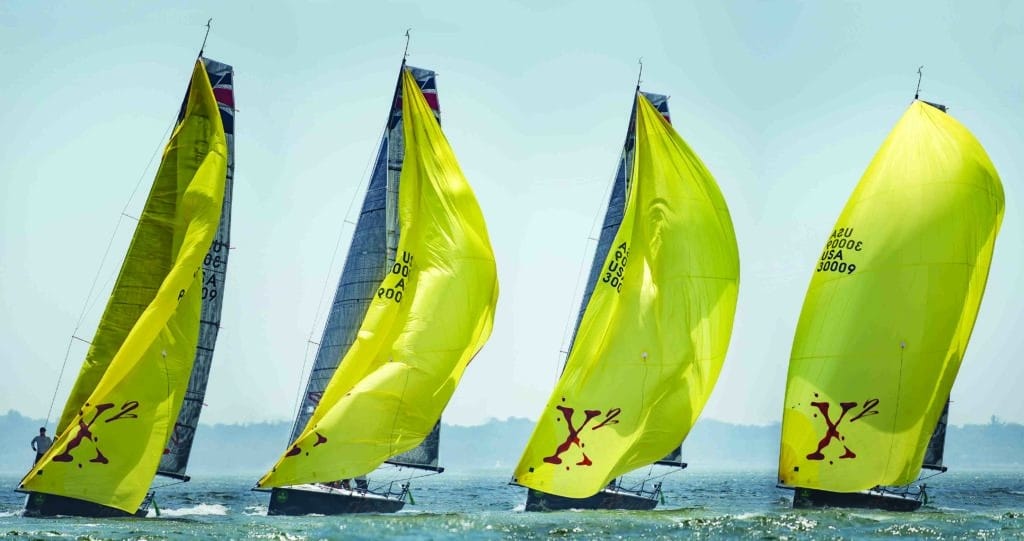
While technological developments usually “trickle down” from bigger boats to smaller boats, advances in technique usually trend in the other direction. That’s the case with blow-through jibes. Imagine if you told your Melges 32 team that you had a great new idea for jibing in a breeze that began with turning the boat down really fast and then backing the spinnaker on the windward side of the boat. They’d wonder how long you’d stayed at the bar the night before. On the other hand, if you told your team that this is how 49ers jibe, and it’s really fast, they might be willing to give it a try. That’s exactly what has happened with blow-through jibes, and they’ve become the go-to jibe for modern, high-performance keelboats.
The reason this technique is so fast is that it keeps the boat more controllable than in a conventional jibe. The boat is going faster when you’re turning the rudder, keeping more flow across the rudder, which means more control and a reduced chance of stall. The cost? You give up a nice, long turn down and the accompanying VMG gain toward the leeward mark. But most have concluded that it’s clearly worth it.
Blow-through jibes can also be a real tactical weapon because of the speed of the jibe. In a normal jibe, you need to start turning down and casting off the sheet to pull the chute around. That whole process, from start to when the main comes across, might take as long as five seconds. In essence, you’re clearly telegraphing to your competition that you’re jibing. A blow-through jibe is so fast that by the time your competition reacts, you’ve completed the jibe.
It used to be that blow-through jibes were used only when the breeze was on, but as techniques have developed, the velocity floor has been pushed down. The Melges 32 used to use them in 20 knots. Now it’s done in as little as 11 knots. The limiting factor in lighter air is that it’s hard to get the chute to back and blow through. Plus, these jibes require a really fast turn, which is never a good thing to do in light wind.
Boat size is also a limiting factor. On larger boats that use winches for chute trim, such as TP52s and RC44s, even with efficient winching, trimmers cannot keep up with the speed of this maneuver. But for small and midsize high-performance boats, it’s perfect. The most important part of an effective blow-through jibe is the speed with which the helmsman turns the boat. The turn needs to be so fast that it almost throws you off the back of the boat. For the helmsman, one trick to help find the rate of turn is that, if you find you’re losing your balance or getting thrown around and just can’t see what’s happening, then go to leeward just before the jibe. In the Melges 32 Worlds in San Francisco, we got our helmsman to move to the other side of the boat before he turned. We’d say, “Stand by to jibe,” and he would go to leeward and sit there while turning the boat through the jibe. That way, he didn’t have to move in the middle of the jibe; he could really nail the new jibe angle. Moving the weight to leeward is not a perfect solution, as it will slow you down, but it can make the jibe easier, especially if it’s new to you.
The fast turn is necessary because it reduces the apparent wind on the chute by rapidly moving the bow downwind. On a skiff such as a 49er, you can actually see the spinnaker get soft during the turn. That decrease in pressure allows the crew to trim the spinnaker sheet in preparation for the turn. On a 49er, it’s basically a little pump as the bow turns down. On the C&C 30, we sometimes need two people to pull on the sheet. The goal is to get the spinnaker clew trimmed in to the shrouds, or to maybe a few inches behind them before the main comes across. If the geometry works out right, at certain windspeeds, the spinnaker clew might end up there anyway. I sometimes put marks on the sheets where they exit the turning blocks so the crew knows how far to trim it. They can easily look down at the turning blocks and see exactly where they are.

As you say, “Start the jibe,” one person runs to the leeward shroud, grabs the clew as the boat is turning down, and pulls it down really hard. If that person can get the clew to hit the deck, that’s great. The downward pull keeps the leech vertical and tight, which prevents the sail from twisting. If the clew is up and loose as the boat turns down, the head of the spinnaker will stay set in the wrong direction, and you’ll get an hourglass. The goal is to have the clew at the shrouds, leech vertical, and the sail backed against the jib before letting the sheet go.
The key to making this work is to not let the backed sail go too early. You can sit there all day with the spinnaker backed, and the boat will be fine. Nothing will rip. Watch the top of the sail. The bottom of the sail will back at first, and the head may still be open the wrong way.
At the same time, the new spinnaker sheet has to be tensioned to minimize the amount of trimming needed once the old sheet has been released. As soon as the chute has backed, someone says, “Cut!” The person at the shroud releases his or her hold on the clew, and the wind pressure pushes or blows the sail through, between the front of the jib and the end of the spinnaker pole. You’ll probably never see a spinnaker move so quickly. And because there is already tension on the new spinnaker sheet, the sail will be almost trimmed as it goes out on the new side.
Typically, the new sheet will need one or two quick pulls after the chute blows through. That’s why it’s important for the helmsman to keep the boat a little deep coming out of the jibe — not quite on the new jibe angle yet. At that point, communication is vital. Often, someone who can see the angle, like the mainsail trimmer, has said, “One pull” or “Two pulls,” letting the trimmers know how far they need to trim. Once the sail is in, the boat will accelerate, the helmsman can turn up, and you’ll start ripping again. Done well, the entire jibe will take only two to three seconds.
If it’s windy and you don’t have the power to get the spinnaker in quickly on the new jibe, the helm might need to stay a bit low and coordinate coming up with the trimming. It also helps to have a big person doing the trimming. If you don’t have someone like that, you can have two people trim. Depending on your personnel and the cockpit layout, the two can pull together, or the person who is holding tension on the sheet when the sail blows through can take up the slack, and the next person can then jump in and do the next pull in a sort of handoff.









